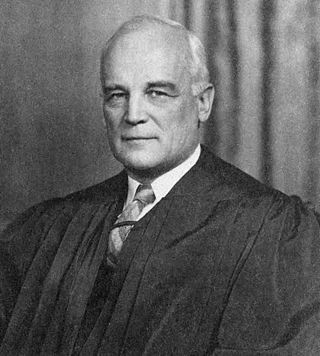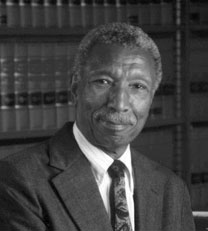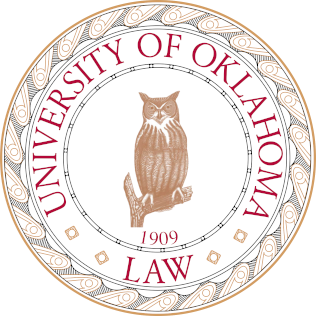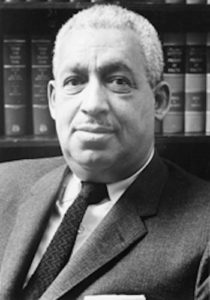
Thurgood Marshall was an American civil rights lawyer and jurist who served as an associate justice of the Supreme Court of the United States from 1967 until 1991. He was the Supreme Court's first African-American justice. Prior to his judicial service, he was an attorney who fought for civil rights, leading the NAACP Legal Defense and Educational Fund. Marshall was a prominent figure in the movement to end racial segregation in American public schools. He won 29 of the 32 civil rights cases he argued before the Supreme Court, culminating in the Court's landmark 1954 decision in Brown v. Board of Education, which rejected the separate but equal doctrine and held segregation in public education to be unconstitutional. President Lyndon B. Johnson appointed Marshall to the Supreme Court in 1967. A staunch liberal, he frequently dissented as the Court became increasingly conservative.

Lloyd Lionel Gaines was the plaintiff in Gaines v. Canada (1938), one of the most important early court cases in the 20th-century U.S. civil rights movement. After being denied admission to the University of Missouri School of Law because he was African American, and refusing the university's offer to pay for him to attend a neighboring state's law school that had no racial restriction, Gaines filed suit. The U.S. Supreme Court ultimately ruled in his favor, holding that the separate but equal doctrine required that Missouri either admit him or set up a separate law school for black students.
Sweatt v. Painter, 339 U.S. 629 (1950), was a U.S. Supreme Court case that successfully challenged the "separate but equal" doctrine of racial segregation established by the 1896 case Plessy v. Ferguson. The case was influential in the landmark case of Brown v. Board of Education four years later.

Harold Hitz Burton was an American politician and lawyer. He served as the 45th mayor of Cleveland, Ohio, as a U.S. Senator from Ohio, and as an associate justice of the Supreme Court of the United States.
McLaurin v. Oklahoma State Regents, 339 U.S. 637 (1950), was a United States Supreme Court case that prohibited racial segregation in state supported graduate or professional education. The unanimous decision was delivered on the same day as another case involving similar issues, Sweatt v. Painter.

The NAACP Legal Defense and Educational Fund, Inc. is a leading United States civil rights organization and law firm based in New York City.
United States v. Virginia, 518 U.S. 515 (1996), is a landmark case in which the Supreme Court of the United States struck down the long-standing male-only admission policy of the Virginia Military Institute (VMI) in a 7–1 decision. Justice Clarence Thomas, whose son was enrolled at the university at the time, recused himself.

Robert Lee Carter was an American lawyer, civil rights activist and a United States district judge of the United States District Court for the Southern District of New York.
Lucy v. Adams, 350 U.S. 1 (1955), was a U.S. Supreme Court case that successfully established the right of all citizens to be accepted as students at the University of Alabama.
The University of Texas School of Law is the law school of the University of Texas at Austin, a public research university in Austin, Texas. Texas Law is consistently ranked as one of the top law schools in the United States and is highly selective—registering the 8th lowest acceptance rate among all U.S. law schools for the class of 2022—with an acceptance rate of 17.5%. According to Texas Law’s 2019 disclosures, 90 percent of the Class of 2019 obtained full-time, long-term bar passage required/JD advantage employment nine months after graduation.
Missouri ex rel. Gaines v. Canada, 305 U.S. 337 (1938), was a United States Supreme Court decision holding that states which provided a school to white students had to provide in-state education to Black students as well. States could satisfy this requirement by allowing Black and white students to attend the same school or creating a second school for Black students.

The University of Oklahoma College of Law is the law school of the University of Oklahoma. It is located on the University's campus in Norman, Oklahoma. The College of Law was founded in 1909 by a resolution of the OU Board of Regents.
Murray v. Pearson was a Maryland Court of Appeals decision which found "the state has undertaken the function of education in the law, but has omitted students of one race from the only adequate provision made for it, and omitted them solely because of their color." On January 15, 1936, the court affirmed the lower court ruling which ordered the university to immediately integrate its student population, and therefore created a legal precedent making segregation in Maryland illegal.

Ada Lois Sipuel Fisher was a key figure in the Civil Rights Movement in Oklahoma. She applied for admission into the University of Oklahoma law school in order to challenge the state's segregation laws and to become a lawyer.
Shelley v. Kraemer, 334 U.S. 1 (1948), is a landmark United States Supreme Court case that held that racially restrictive housing covenants cannot legally be enforced.

William Robert Ming Jr. was an American lawyer, attorney with the National Association for the Advancement of Colored People (NAACP) and law professor at University of Chicago Law School and Howard University School of Law. He presided over the Freeman Field mutiny court-martials involving the Tuskegee Airmen. He is best remembered for being a member of the Brown v. Board of Education litigation team and for working on a number of the important cases leading to Brown, the decision in which the United States Supreme Court ruled de jure racial segregation a violation of the Equal Protection Clause of the Fourteenth Amendment of the United States Constitution.
NCAA v. Board of Regents of the University of Oklahoma, 468 U.S. 85 (1984), was a case in which the Supreme Court of the United States held that the National Collegiate Athletic Association (NCAA) television plan violated the Sherman and Clayton Antitrust Acts, which were designed to prohibit group actions that restrained open competition and trade.
Fletcher S. Riley was a justice of the Oklahoma Supreme Court for 24 years, from 1924 to 1948. He died in December 1966 in Bethany, Oklahoma.
Silas Herbert Hunt was a U.S. veteran of World War II who became the first African American student to enroll in a white Southern university since the Reconstruction era. He enrolled in the University of Arkansas School of Law on Feb. 2, 1948, breaking the color barrier in higher education and starting integration of colleges and universities in the South.
Romeo Marcus Williams was an American civil rights attorney who organized large-scale student protests against segregation in Marshall, Texas. He was also a junior partner of Dallas, Texas civil rights attorney, William J. Durham, who served as lead counsel on two landmark U.S. Supreme Court cases, Sweatt v. Painter, and Smith v. Allwright.








